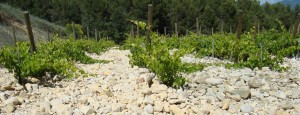The Rhone – North vs. South
The Northern and Southern Rhone share the moderating effects of the Rhone River, the Mistral and share a few grapes varieties. But in terms of climate, soils, terrain and wine styles, they are quite different. The Northern Rhone has a continental climate, slightly cooler, less sunny and slightly wetter than the South which is more Mediterranean. The Mistral – the cool wind from the North – has less impact in Cote-Rotie, the narrowest part of the Rhone, and only begins to pick up speed in Hermitage where the Valley begins to widen. The full brunt of the Mistral is felt in the broader plains of the Southern Rhone. The soils in the Northern Rhone are granite-based whereas in the South, there is more limestone and alluvium such as the large rounded river stones called galet (“gal-lay”) found in Chateuneuf du Pape. The terrain can be much steeper in the North, with some vineyards in Cote-Rotie planted on terraces carved out by the Romans centuries ago. Guigal’s La Londonne vineyard is on a 45 degree slope.
Because of the cooler conditions in the Northern Rhone, the early-ripening Syrah grape performs well here and is the sole red grape authorized for the red wine appelations. The Northern Rhone is primarily “Cru” production of dry red wines based on Syrah and very little generic Cotes du Rhone. They are from the North: Cote-Rotie, the smaller appelations of Condrieu (white), Chateau Grillet (sweet white), Hermitage, Crozes-Hermitage, Saint-Peray (white) and Cornas.
In the warmer and drier conditions of the Southern Rhone, more grape varieties can be planted, in fact up to 23 red and white grapes are allowed. By far the most important grape variety is the black grenache, native of Spain where it is known as garnacha. Grenache is well-suited to the climate because of its wind- and drought- resistance. Grenache has an upright growing habit that can be pruned low to the ground and has sturdy wood structure, both of which help it to resist the Mistral. Grenache also produces more of a hormone called abscisic acid which signals the leaves to close its pores to prevent evaporation of moisture when it becomes too hot, dry and windy. Grenache produces more of this hormone than Syrah.
Grenache – both red and white types – is a high sugar, higher alcohol grape variety and in the warmer conditions of the Southern Rhone, alcohol management is always a challenge. It is also lower in tannins and acidity. Southern Rhone wines therefore are typically blends. For reds, it often means adding syrah to add color, structure and acidity. For whites, it may mean adding high acid bourboulenc or piquepoul to grenache blanc or viognier.

